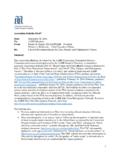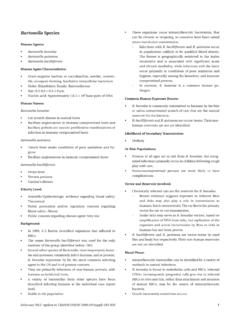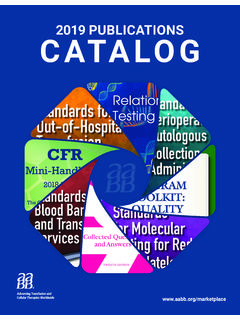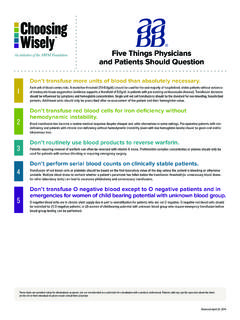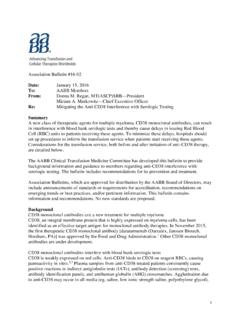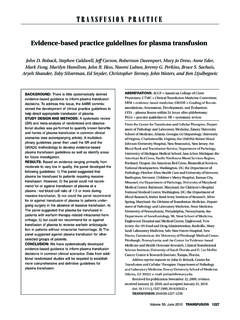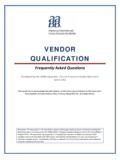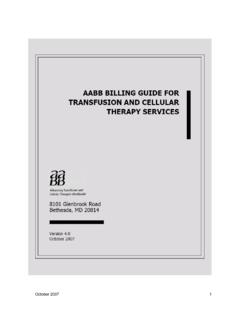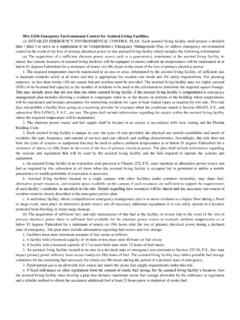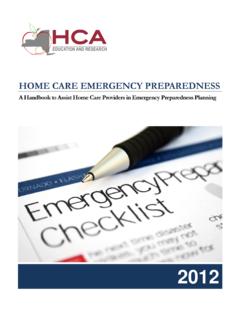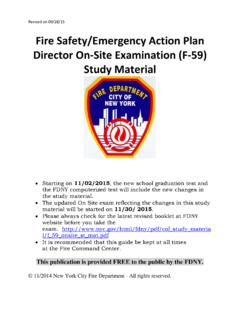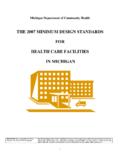Transcription of Standards for Blood Banks and Transfusion Services, 29th ...
1 Standards for Blood Banks and Transfusion services , 29th edition summary of Significant Changes The following table summarizes many of the significant changes made to the 29th edition of Standards for Blood Banks and Transfusion services ; it is not, however, exhaustive. Not all changes contained in the Standards have been incorporated in detail. Many of the changes that result in the reorganization of a section cannot be fully appreciated without consulting the 29th edition of Standards in conjunction with this table; therefore, the numbering follows that of the 29th edition and, where appropriate, the corresponding standard number in the 28th edition is included in parentheses. In cases where a standard has been re-numbered, but the substance of the standard has not changed, there is often no entry listed in the table. Like the crosswalk published with the Standards , this table is offered to assist individuals in updating their facility s policies, processes, and procedures to conform to the 29th edition .
2 Use of this table should not take the place of a thorough, line-by-line analysis of each standard. Please note that this summary includes examples of comments submitted by users of the document, along with the program unit s rationale in making or not making a revision to the document. 29th edition standard number (28th edition number in parentheses if changed) Source of change (Changes are made either in response to public comments or as the result of a program unit decision made prior to the public comment period.) Outcome Following Program Unit Discussion (Please note that public comments address the proposed Standards . The changes are best understood when the proposed Standards is compared to the final published version. The program unit has elected to make the substance of public comments a part of this document.) Public comment submitted, no change made Comment: If I (technical specialist) am the person who deals with all the quality issues (generating reports, writing variances, daily/weekly/monthly quality reviews, validations, etc.)
3 And I report personnel issues to a supervisor (general lab supervisor), Blood bank issues to the lab manager, and the Blood bank medical director and the lab manager and Blood bank med. Director report to executive management, does this follow the standard? Should this quality representative be from the hospital s Quality Management Department or am I sufficient? Outcome: The committee noted this comment, but did not feel that a change was needed at this time. The committee feels that the process as described would meet the intent of the standard as written. Regarding the individual that performs the duty of the quality representative, as long as said individual is qualified by training and experience they would be able to serve in that role. Public comment submitted, change made Comment: Original wording is not clear whether the exceptions are case-by-case or the medical director approval is case-by-case, which means that medical director approval would not be needed in some cases.
4 Shouldn t the medical director approve all exceptions? Recommend the following edit: Any exceptions to policies, processes, and procedures warranted by clinical situations shall require justification and preapproval by the medical director on a case-by-case basis. 29th edition (28th edition ) Source of change Outcome Version 1, February 27, 2014 2 Outcome: The committee reviewed this comment and agreed with the suggestion and the change was made. The standard now reads as suggested by the comment. , Public comment submitted, no change made Comment: PI would like to suggest the possible revision to each standard The Blood bank or Transfusion service shall develop, test and evaluate emergency operations plans, policies, processes, and procedures to prevent, mitigate, prepare for, respond during and recover from emergencies and disasters, including those resulting from natural, man-made and technological hazards the effects of internal and external disasters.
5 The emergency plan should shall including emergency communication systems, shall be tested at defined intervals. address such topics as communications, assignments and training for staff, supplies, equipment, facilities and collaboration with external partners. The emergency plan shall be tested, evaluated and revised as needed at least once per year. Rationale: The current standard is non-specific and overly broad. Even though the AABB's emergency preparedness materials are fairly good, the current standard fails to mention many key activities that should be part of emergency preparedness and response. The standard as written could be interpreted to require little more than an occasional test of a Blood bank 's emergency phone tree. The standard should be revised to be consistent with FEMA, NFPA and others who identify four or five phases of emergency management: prevention, mitigation, preparedness, response and recovery.
6 Blood establishments should be broadly prepared for a variety of hazards in accordance with federal recommendations ( ; gov/planning-preparedness/; ; ). The AABB standard should include a specific recommended interval for testing, evaluating and revising the emergency plan and mention staff training and evaluation and encourage collaboration with local emergency management offices, health departments and other stakeholders ( ) Outcome: The committee reviewed these comments but did not feel the changes suggested were appropriate at this time. Regarding standard , the committee intentionally wrote this standard in a manner that allows more flexibility for the user to develop their disaster plans. They did not think that the addition of specific requirements would serve the greater community as disasters can be diverse in nature. The committee notes that a facility is free to include these as part of their plan if they so choose.
7 Concerning standard , the committee again felt that leaving the standard less specific and broader would be more appropriate. In the future, the committee plans to create guidance concerning these Standards to assist in their implementation and will provide common examples to the membership. , , #3 Public comment submitted, change made Comment: Please add a record retention requirement to this standard. As an assessor, it is difficult to determine whether the Standard is being met and that the required testing actually occurs at defined intervals if the facility is not being required to create records of this testing. Outcome: The committee agreed with this comment and added a record retention symbol to align with the standard. The committee incorporated this into and assigned a two year record retention period to this standard. The two year period was based on the lifecycle of this edition of Standards .
8 Public comment submitted, change made Comment: Suggested edit: All equipment shall be initially qualified for its intended use. Outcome: The committee agreed with this comment and the change was made. The word initially was felt to be limiting. 29th edition (28th edition ) Source of change Outcome Version 1, February 27, 2014 3 , #3 Public comment submitted, change made Comment: Both and allow following manufacturer s written instructions as a minimum. Standard #3 does not state this which seems to indicate that forever thermometers need to be calibrated at prescribed intervals even though the manufacturer s written instruction allow this to be omitted. Outcome: The committee agreed with the intent of this comment and has added the clause, ..as described below unless otherwise indicated by the manufacturer: to appear at the end of the second sentence of the header. The standard now reads as follows: Calibration of Equipment Calibrations and/or adjustments shall be performed using equipment and materials that have adequate accuracy and precision.
9 At a minimum, calibrations and/or adjustments shall be performed as described below unless otherwise indicated by the manufacturer: Public comment submitted, change made Comment: Suggested edit: Internal storage temperatures of refrigerators, freezers, and platelet incubators shall be monitored. Outcome: The committee agreed with the suggested change as indicated. The committee felt that the term storage could be a bit limiting and could cause a misunderstanding that the standard was only focusing on the temperatures of a piece of equipment s motor and not the actual temperature inside the devices listed in the standard. Public comment submitted, change made Comment: 660 does not apply to containers and solutions. Recommend adding the following additional CFR cites to cover containers and solutions: , (b), and (d). Outcome: The committee noted this comment and agreed to add references , (b), and (d) but also kept 21 CFR 660 as it relates to reagents which are described in the standard.
10 Public comment submitted, change made Comment: Detection methods shall either be cleared or approved by the FDA or be validated to provide sensitivity equivalent to FDA-approved methods. FDA does not approve these tests. Outcome: The committee noted this comment, and to ensure there was no confusion, the end of the standard was re-written to include the phrase, ..equivalent to FDA-cleared or approved methods. Committee decision The committee elected to edit standard to remove the term appropriate as it concerned the sample in the first sentence. The committee felt this was inherent to the requirement, the change does not change the standard s intent or how it should be interpreted. Public comment submitted, change made Comment: Please be advised that (a)(1) requires more information be captured in the records in addition to the identifying the person and date when task was done.

